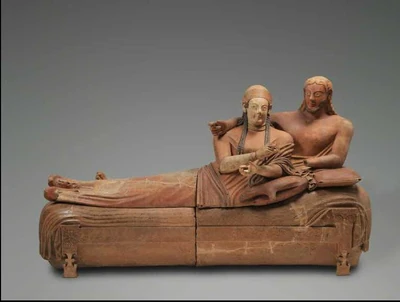
The Sarcophagus of the Spouses, an Etruscan sarcophagus dating c. 520-510 BCE
Brief Identification[]
Also known as the "Sarcophagus of the Bride and Bridegroom" and the "Sarcophagus of the Married Couple", this particular artifact was found in modern-day Cerveteri, Italy. Cerveteri was once known as Caere , an Etruscan city that thrived in the 7th to 3rd centuries prior to Roman rule of the Italian peninsula. Produced by the Etruscans, it served as an ornate burial container for citizens in a civilisation that believed very strongly in the afterlife. It was created sometime between the years 520 and 510 BCE.
Technical Evaluation[]
Sarcophagi are containers generally constructed of stone, terra cotta, or other materials and are meant to hold the bodies or ashes of the deceased. Measuring 1.11 m by .69 m by 1.94 m, the sarcophagus in question is made out of terra cotta, a crafting material derived from clay. The sarcophagus was made in four separate sections, and each section was fired separately [Kleiner 2010, 31]. After its assembly, the sarcophagus was painted to highlight details in the sculpting. Terra cotta was a substance commonly used in the manufacturing of Etruscan sarcophagi due to its availability and low cost [Vaughan 1964, 30]. Stone was very rarely used for Cerveteri sarcophagi, even though local sandstone and volcanic tuff varieties were available, because its use did not encourage advanced craftmanship [Bonfante 1986, 107]. Terra cotta was preferred by local artisans because of the freedom of movement it allowed and because it could be painted and adorned in ways that stone sculptures could not [Heurgon 1964, 27]. In addition, "the clay could be quickly and easily worked, successful models could be repeated because of the use of moulds, and the brightly coloured surfaces allowed a wide range of effects for decorative or expressive purposes" [Bonfante 1986, 123].
According to the Louvre Museum , "The Sarcophagus of the Spouses was found in 1845 by the Marquis Campana in the Banditaccia necropolis in Caere (modern Cerveteri)" [Louvre 2013]. The sarcophagus has since been returned Italy and now resides in The Villa Giulia National Etruscan Museum in Rome [Moretti 2001, 3].
Local Historical Context[]
For the Etruscans, "making containers for the dead was an industry" [Barker and Rasmussen 1998, 289]. Sarcophagi were extensively used as burial containers, and wealth allowed certain individuals to customise and lavishly decorate their own. Sarcophagi were produced locally by workshops in which burial containers and architectural decorations were produced simultaneously [Bonfante 1986,101]. So large was the sarcophagi industry that some scholars speculate that "shops kept in stock what the trade required, or fashion demanded, ain the way of sculptured sarcophagi and funerary urns, and that when the proper time came, the customer'shehehe
own head was modeled and attached to whatever torso or full length figure he desired" [Vaughan 1964, 34]. Regardless of the presence of stock models for sarcophagus construction, sarcophagi were still highly personalised and expensive burial options and ornate ones were reserved for the noble and the elite.
The design of the sarcophagus demonstrates cultural beliefs unique to the Etruscans, specifically the value assigned to women. Though recumbent figures were commonly placed atop sarcophagi during the Archaic period, Greek art from the same time rarely featured women; in this case the sculpture atop the sarcophagus is that of a couple posed in an intimate manner [Cummings 2012, 32]. The presence of the woman upon the sarcophagus indicates a greater value for women in Etruscan society. Etruscan culture and art as a whole was more favourable to women, and some scholars speculate the sarcophagi were originally intended for women "to preserve the remains better and to increase the inviolability of the funeral couch" [Heurgon 1964, 95].
World-Historical Context[]
The sarcophagi produced by the Etruscans are very similar to those produced by the Ancient Egyptians, though their Egyptian counterparts were more often made of stone. The religious practises of the two groups differed, but they shared a common practise of lavishly filling tombs with all the items the deceased would need in the afterlife. Sarcophagi were also extensively used throughout Greek and Roman territories as the primary burial practise . While each of these cultures utilised the sarcophagus, the decoration and contents of the sarcophagi varied. Roman, Greek, and Etruscan sarcophagi were traditionally decorated with three dimensional representations of the deceased they bore within [Heurgon 1964, 52]. Etruscan funerary traditions allowed for both inhumation and cremation, with the remains from both being deposited in sarcophagi [Modona 1968, 109]. The use of sarcophagi in Egyptian, Greek, and Roman cultures was primarily as a repository for a body.
The widespread use of the sarcophagus demonstrated its favourability as a repository human remains. Differences in cultural practises of the civilisations who utilised them indicated the adaptability of the burial practise. Additionally, the care and respect that each culture demonstrated for their dead presents a world-wide phenomenon unique to human life.
Suggested Bibliography[]
Barker, Graeme, and Rasmussen, Tom. The Etruscans. Oxford: Blackwell Publishers Ltd., 1998.
Bonfante, Larissa, ed. Etruscan Life and Afterlife. Detroit: Wayne State University Press, 1986.
Cummings, Laura. “The Portrayal of Death and the Afterlife in Etruscan Sarcophagi.” Citations, Journal of Undergraduate Research 9 (2012): 31-33. Accessed April 21, 2013. http://www.lagrange.edu/resources/pdf/citations/2012/04_Cummings_ArtHistory.pdf.
Encyclopedia Britannica. “Caere.” Accessed April 21, 2013. http://www.britannica.com/EBchecked/topic/88078/Caere.
Encyclopedia Britannica. "Burial." Accessed April 22, 2013. http://www.britannica.com/EBchecked/topic/85256/burial?anchor=ref110692.
Heurgon, Jacques. Daily Life of the Etruscans. Translated by James Kirkup. London: Phoenix Press, 1964.
Kleiner, Fred S. A History of Roman Art, Enhanced Edition. Independence: Wadsworth Publishing, 2010.
The Louvre. “The Sarcophagus of the Spouses.” Accessed April 22, 2013. http://www.louvre.fr/en/oeuvre-notices/sarcophagus-spouses.
The Metropolitan Museum of Art. “Etruscan Art.” Accessed April 22, 2013. http://www.metmuseum.org/toah/hd/etru/hd_etru.htm.
The Metropolitan Museum of Art. “Roman Sarcophagi.” Accessed April 22, 2013. http://www.metmuseum.org/toah/hd/rsar/hd_rsar.htm.
Modona, Aldo N. A Guide to Etruscan Antiquities. Translated by Andrew Page. Florence: Tipolitografia F.lli Linari, 1968.
Moretti, Anna M., ed. The Villa Giulia National Etruscan Museum. Rome: L’erma di Bretschneider, 2001.
Vaughan, Agnes C. Those Mysterious Etruscans. New York: Doubleday and Company, Inc., 1964.